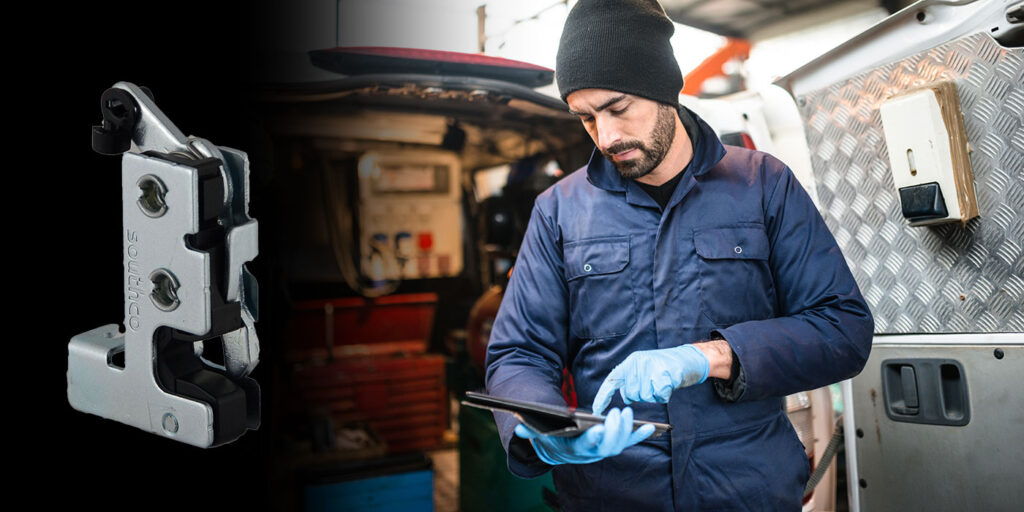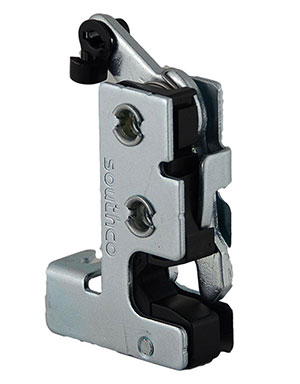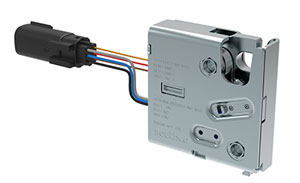Pickup trucks, delivery vans and other kinds of work trucks are some of the most hardworking machines in use in the world today. Businesses from one-person contractors to large utilities and e-commerce operations with fleets of trucks depend on these workhorse vehicles to get the job done every day.
The OEMs that build these vehicles are constantly seeking ways to enhance their security, comfort and usability, since many contractors, technicians and delivery personnel spend hours in these cabs daily. Personnel are in and out of the vehicle multiple times a shift—which means that door latches and locking mechanisms are actuated far more frequently than typical passenger vehicles.
E-commerce delivery vans and utility trucks also have rear doors that access package storage or equipment lockers: these are high value targets for thieves and vandals, so enhanced protection is a critical requirement.
Work truck OEMs are always in search of ways to differentiate their products and enhance both the operator environment and performance of vehicles. There is a range of access control devices, such as high-quality latches and electronic locks, and position control hinge technologies that offer vehicle designers a wide variety of cost-effective and distinctive tools to help meet their quality and performance goals.
From simple position control hinges that improve ergonomics by making flatscreens easily adjustable by one hand, to electronic access solutions that offer sophisticated security and usage tracking platforms for fleet managers, there are many ways that access and position control systems can enhance the touchpoint experience of work truck operators and fleet owners.
Significant work truck growth spurs demand for improved features
Macroeconomic trends are driving the growth of a wide range of work trucks, with particularly strong growth in delivery vehicles. The shift in consumer preferences to greater online shopping, at-home delivery of groceries and other products and other trends driving e-commerce has led van manufacturers to significantly expand production to meet demand, especially from large fleet operators.
Vehicle OEMs are working with fleet operators to understand what features and amenities they seek in order to build their brands and win sales. Truck and van manufacturers are seeking products and devices that are cost-effective to help keep costs down yet add quality and durable performance to key application zones in their vehicles.
One way that access and position control suppliers can help vehicle OEMs meet fast-growing demand while also controlling costs is by providing products that have been tested for compliance with regulations such as the U.S. Federal Motor Vehicle Safety Standards (FMVSS). These standards are designed to ensure that products such as position control hinges or latching systems function securely and do not fail when subject to sudden stops or impact situations.
For example, one leading position control device manufacturer is offering for use in vehicle cabs a newly developed arm designed to support digital devices such as tablets and laptops. This double articulating design allows the arm to be installed in a center console or even a door before storage and deployment as needed. While seemingly similar articulating arms could be purchased on the open market from computer or business supply stores, they wouldn’t have been tested to meet the rigorous demands of work and delivery trucks.
By working with a supplier whose hinge and latch hardware has been certified simplifies the process OEMs must follow to ensure their vehicle safe for large fleet operators purchase. By working with fleet operators, work truck OEMs can have a better understanding of these and other requirements and then select suppliers who can cost-effectively provide the right devices for their vehicles.
Reliable latching and electronic access systems
A typical driver, passenger or rear access door would go through approximately 100,000 open-and-close cycles during its operational life. Delivery vans and other work truck driver doors and rear doors undergo much greater usage, day in and day out — by some estimates, five to ten times more cycles.
As a result, work truck OEMs need to consider selecting proven locking and latching mechanisms that have been tested through hundreds of thousands of cycles. At the same time, latching and locking mechanisms must incorporate ergonomic features that make them easy to operate so that delivery personnel and technicians aren’t slowed down by constantly needing to lock and unlock doors and cabinet panels.
Electronic access solutions (EAS) are a powerful tool that work truck OEMs are increasingly interested in using for both driver and rear storage area access options. There is a range of electronic locks and EAS platforms available. Many electronic access technology suppliers have portfolios covering price ranges and materials ranging from all-plastic to all-metal construction.
Most vehicles today have electronic locks; for work trucks, there are versions that have been configured to support unique requirements associated with delivery and contractor access needs. Often, workers accessing the rear door of a delivery van or technician’s truck will have their hands full, so many OEMs are installing electronic locks that use proximity sensors to detect a worker’s key fob and automatically unlock as they approach the vehicle; when the user walks far enough away from the vehicle, it can automatically re-lock.
There are more advanced EAS platforms that provide useful tools for fleet management and security. There are access control manufacturers that supply complete EAS products that include electronic locks with Bluetooth interfaces, smartphone apps and cloud-based programs that provide secure electronic keys and audit trail capabilities.
These solutions are also useful for fleet operations where delivery personnel or technicians use a different truck every day. Instead of issuing and managing physical key fobs, electronic keys can be sent over the air; the electronic locks have a Bluetooth interface that can receive the electronic key for that driver to use that vehicle for a given shift. The cloud-based system can keep track of all the vehicles and also be alerted if any attempts are made to break into the truck by prying the latch.
Another simple yet effective option vehicle OEMs can choose to protect against vandalism and theft is the use of hidden electronic latches and door hinges. By using an automatic lock, no exterior latch handle needs to be installed, and the latching points can be located anywhere on the door, rather than in the middle. Hidden hinges installed on the inside of the door also make it difficult for thieves to guess where to try prying the door open. Thieves want to act fast while the driver is gone, and if they don’t know where to start prying, they don’t waste their time.
Range of hinge options for improved ergonomics
E-commerce delivery van designers seek to maximize the storage spaces in their vehicles for a wide range of package dimensions; at the same time, these are delivery people’s work areas that need to be easily adjusted during the course of their shift.
As a result, some of these vans have shelving that can be raised and lowered. To provide the right support, a range of constant torque hinges is available that combines ease of use with a higher quality touchpoint experience. Constant torque hinges provide constant resistance throughout the entire range of motion, enabling users to easily position doors, display screens and shelving and hold them securely at any desired angle; when fully lowered, they remain securely in place.
Leading suppliers have enhanced their constant torque lines with newer technology. Asymmetric torque hinges, for larger-sized shelves or heavy doors, have lower torque when lifting the panel but heavier torque assisted by gravity to bring the shelf back down. Both movements make it easier and more ergonomic on the worker to shift shelving as needed during the day, while the smooth motion gives a higher quality impression to the user, compared to basic hinges with no resistance.
Another feature of leading position control and access hardware offerings is how well they are engineered to reduce two factors many vehicle OEMs consider critical: buzz, squeak and rattle, or BSR, and noise, vibration and harshness, or NVH.
Work trucks put in a lot more miles than ordinary vehicles—so if latching and hinge components are poorly engineered or manufactured, their parts can begin loosening and rubbing together, increasing the potential BSR and NVH in the vehicle and detracting from the long-term quality impression associated with the vehicle’s brand.
Torque hinge technology is just one example of the kinds of devices leading access and position control suppliers offer that combat BSR and NVH. For example: screens that are mounted on torque hinges have inherent vibration-absorbing technology, keeping the screen level and locked in place.
The wide range of hinges, latching systems and electronic locks available today can complicate the efforts of work truck OEMs to rapidly design and deliver new vehicles to the marketplace. Working with a proven supplier with a broad portfolio of products and proven solutions already in use in many vehicle applications can help simplify these processes and help produce vehicles that provide the performance and value that fleet managers seek.
Bob Straka is the General Manager, Transportation Industries, at Southco.
















